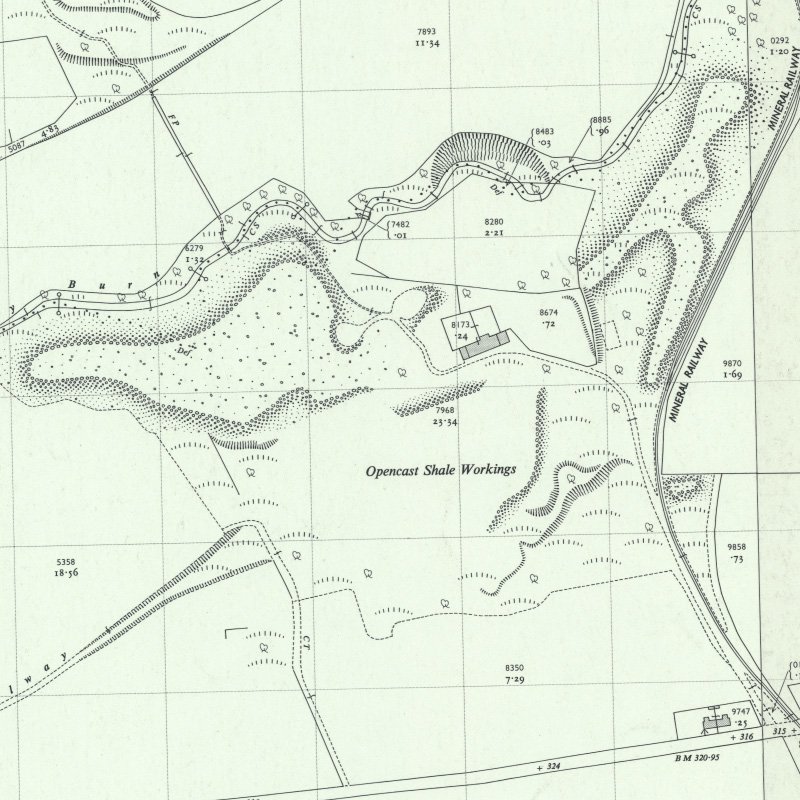- Addiewell No.1 pit
- Addiewell No.1 mine
- Addiewell No.2 pit
- Addiewell No.2 mine
- Addiewell No.3 pit
- Addiewell No.3 mine
- Addiewell No.4 pit
- Addiewell No.5 pit
- Addiewell No.6 pit
- Addiewell No.18 mine
- Albyn mine
- Alderstone No.43 mine
- Baads No.9 pit
- Baads No.15 pit
- Baads No.17 mine
- Baads No.22 pit
- Baads No.23 pit
- Baads No.42 mine
- Boghall No.1 pit
- Boghall No.2 coal pit
- Boghall No.3 pit
- Boghall No.4 pit
- Boghall "Raeburn" mine
- Breichdykes pits
- Breich No. 1 & 2 pits
- Burngrange No. 1 & 2 pits
- Burngrange No. 39 mine
- Burntisland No.1 mine
- Burntisland No.2 mine
- Burntisland No.3 mine
- Burntisland No.4 mine
- Carledubs mine
- Champfleurie mine
- Cobbinshaw No.1 & 2 mines
- Cobbinshaw No.5 mine
- Cobbinshaw South No. 1 pit
- Cobbinshaw South No.28 mine
- Cobbinshaw South No.3 mine
- Cobbinshaw (West Calder Oil) pit
- Cousland No.1 mine
- Cousland No.2 mine
- Crossgreen No.1, 2, & 3 mines
- Cuthill No.24 coal mine
- Dalmeny No.1 pit
- Dalmeny No.2 pit
- Dalmeny No.3 pit
- Dalmeny Railway No.1 & 2 mines
- Deans (Caputhall) mine
- Deans No.1 mine
- Deans No.2 mine
- Deans No.3 mine
- Deans No.3 mine & quarry (W.L.O.C.)
- Deans No.4 mine
- Deans No.4 pit
- Deans No.5 mine
- Deans No.6 mine
- Deans No.7 mine
- Drumcrosshall No1. & No.2 mines
- Drumshoreland Muir pit
- Duddingston No. 1 & 2 mines
- Duddingston No.3 mine & quarry
- Dunnet or Sandholes mine
- Dunnet's mine, East Hermand
- Easter Breich coal mine
- Easter Breich No.1 & 2 pits
- Fivestanks mine
- Fivestanks; unidentified mine
- Forkneuk No.1 & 2 pits
- Forkneuk No.38 mine
- Forkneuk No.9 & 10 pits
- Fraser pit
- Gavieside No.1 pit
- Gavieside No.2 pit
- Gavieside No.3 pit
- Gavieside No.40 mine
- Grange No.1 & 2 pits
- Grange No.3 pit
- Greendykes North mine
- Greendykes South mine
- Greenfield No.1 pit
- Greenfield No.3 mine
- Hartwood mine & coal pit
- Hayscraigs mines and quarries
- Hermand mine
- Hermand (Murray's pool) mine
- Hermand No.5 pit
- Hermand No.6 mine
- Hillend coal pit
- Holmes mine
- Hopetoun No.35 pit
- Hopetoun No.4 mine
- Hopetoun No.1 pit
- Hopetoun No.2 pit
- Hopetoun No.3 mine
- Hopetoun No.41 (Fawnspark) mine
- Hopetoun No.44 mine
- Hopetoun No.5 pit
- Hopetoun No.6 (Glendevon) mines
- Hut mines and quarry
- Ingliston No.33 pit
- Ingliston No.36 & 37 pits
- Lawhead No.1 mine
- Limefield No.32 mine
- Livingston quarries
- Mid Breich No.2 mine
- Mid Breich No.3 pit
- Mid Breich No.4 pit
- Mortonhall No.10 mine
- Mortonhall No.9 mine
- Muirhall No.16 coal mine
- Muirhall No.19 coal pit
- Newbigging No.1 & 2 mines
- Newfarm No.3 & 4 mines
- Newliston No.29 mine
- North Cobbinshaw mine
- Oakbank: Calder wood mine
- Oakbank No.1 & 2 pits
- Ochiltree Colliery - north
- Ochiltree Colliery - south
- Ochiltree No.2 mine
- Ochiltree No.3 mine
- Ochiltree No.5 mine
- Ochiltree No.6 mine
- Pentland No.1 & 2 mines
- Philpstoun No. 1 mine
- Philpstoun No. 1 (Whitequarries) mine
- Philpstoun No. 2 mine
- Philpstoun No. 3 mine
- Philpstoun No. 4 (grey) mine & quarry
- Philpstoun No. 4 mine
- Philpstoun No. 5 mine
- Philpstoun No. 6 (Whitequarries) mine
- Philpstoun No.7 mine
- Polbeth No. 8 pit
- Polbeth No.10 pit
- Polbeth No. 11 pit
- Polbeth No. 20 mine
- Polbeth No. 21 mine
- Polbeth No. 26 mine
- Polbeth No. 27 mine
- Polbeth No. 31 mine
- Polbeth No. 7 & 7½ pits
- Pumpherston No.1 mine
- Pumpherston No.2 mine
- Pumpherston No.3 mine
- Pumpherston No.4 mine
- Pumpherston No.5 mine
- Pumpherston No.6 mine
- Pyothall No.5 pit
- Redhouse No.1 coal mine
- Roman Camp (Cawburn) mine
- Roman Camp No.1 mine
- Roman Camp No.3 mine
- Roman Camp No.4 pit
- Roman Camp No.5 mine
- Roman Camp No.6 mine
- Roman Camp No.7 mine
- Roman Camp (north) No.2 mine
- Roman Camp (south) No.2 mine
- Rosshill No.1 & 2 mines
- Seafield coal mine
- Seafield No.1 mine
- Seafield No.3 mine
- Stankards No.1 pit
- Stankards No.45 mine
- Stewartfield No.1 mine
- Stewartfield No.1 pit
- Stewartfield No.2 mine
- Stewartfield No.2 pit
- Stewartfield No.3 pit
- Stewartfield No.4 pit
- Straiton No.1 & 2 mines
- Straiton No.3 pit & No.3 mine
- Straiton No.4 mine
- Straiton No.8 mine
- Strathbrock collieries
- Tarbrax No.1 pit
- Tarbrax No.2 pit
- Tottleywells No.1 mine
- Viewfield coal pit
- Viewfield No. 4 & 5 pits
- Westwood No.12 pit
- Westwood No.1 & 2 pits
- Westwood No.13 pit
- Westwood No.30 pit
- Woolfords colliery
Hayscraigs mines and quarries

Inclined adits and opencast working
Serving Broxburn Oil Works
A series of mines at the outcrop of the Broxburn Shales in an area that was subsequently opencast. These workings were ultimately linked to those of Pyothall No. 5 Pit. A further phase of open-cast working began immediately after WW2 and continued until 1959 from two quarries; Haycraigs A and Haycraigs B.
Mineral statistics for 1883 record that Haycraigs mine worked the Broxburn shale by stoop and room, 20 being employed above ground and 113 below ground (25 and 175 in 1884), under the management of Alex Kennedy. Downcast and upcast shafts measured 7'x7' and 9'x6' respectively, the fiery workings being ventilated by fan. A second 6x6 downcast shaft is recorded, presumably for ventilation.
Shale-field: Broxburn district.
Mapped by the Ordnance Survey of c.1897, showing areas of quarrying and two mines heading to the south west.
Drawings

From "Sections of Shale Seams", a notebook by Robert Crichton. BP Archive 183734
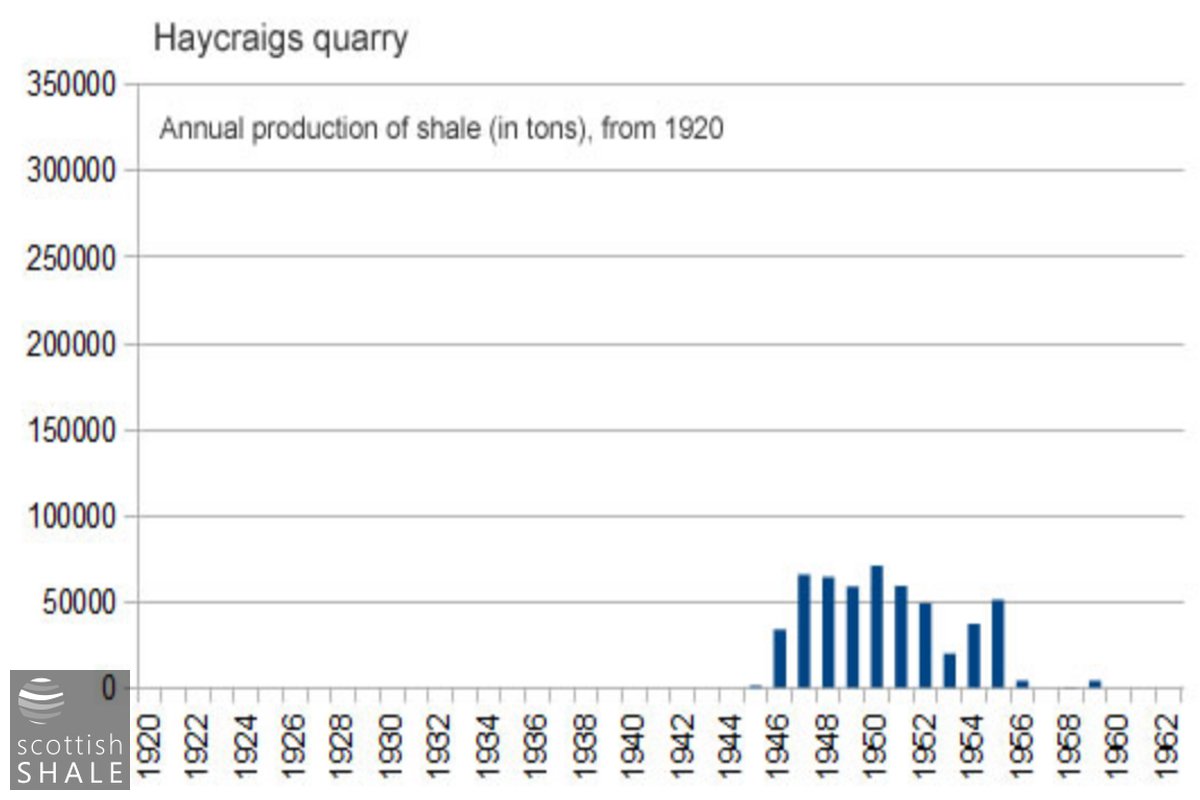
Production statistics.
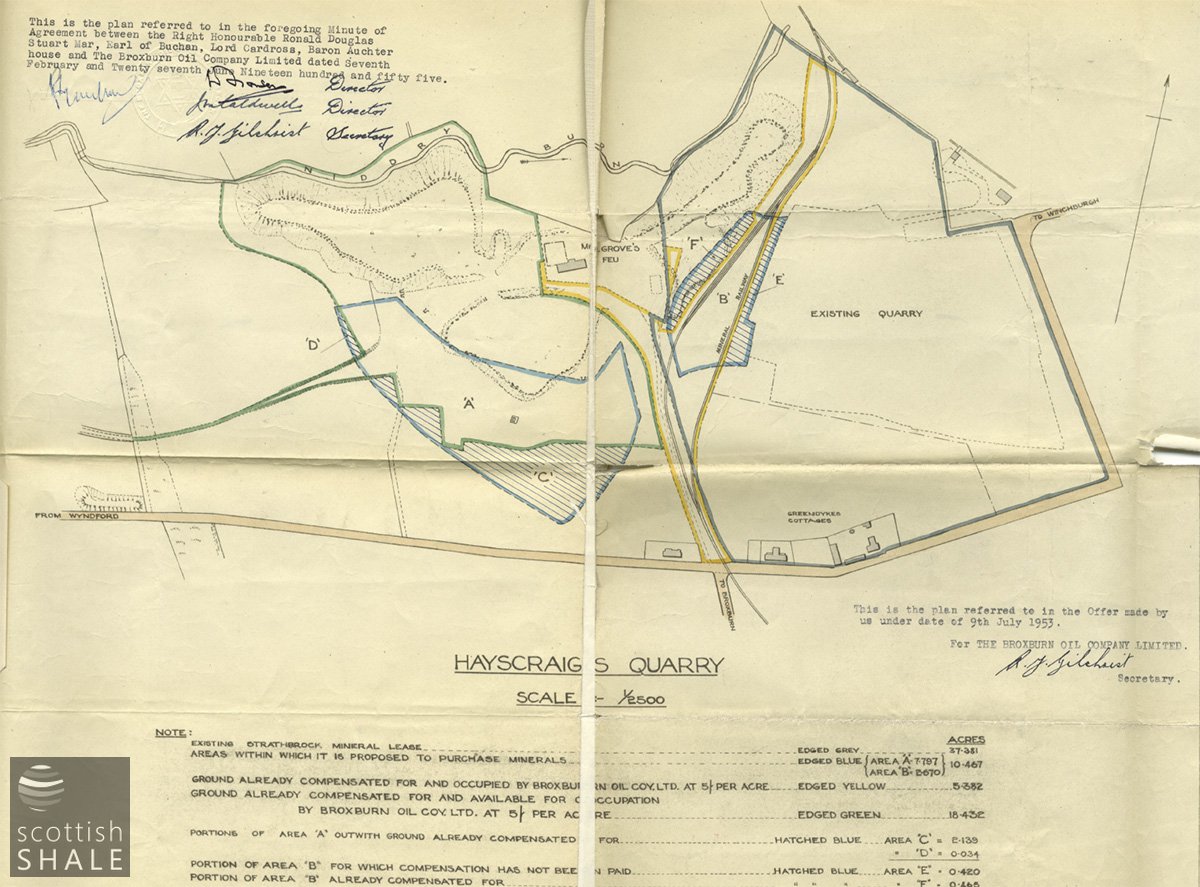
See full record; 194710
Recent images
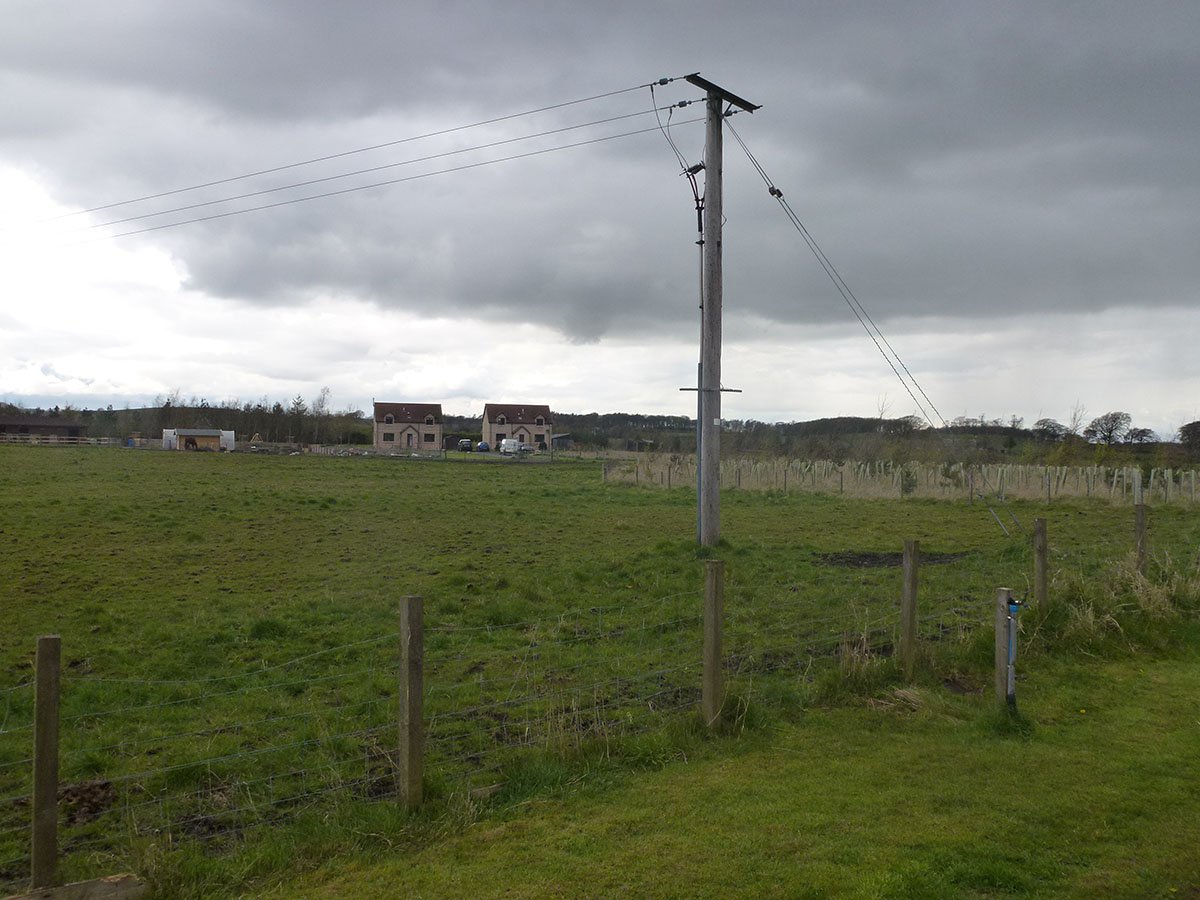
The two houses mark the approximate site of the main staging of the Hayscraigs Mines. Looking north west. April 2012.
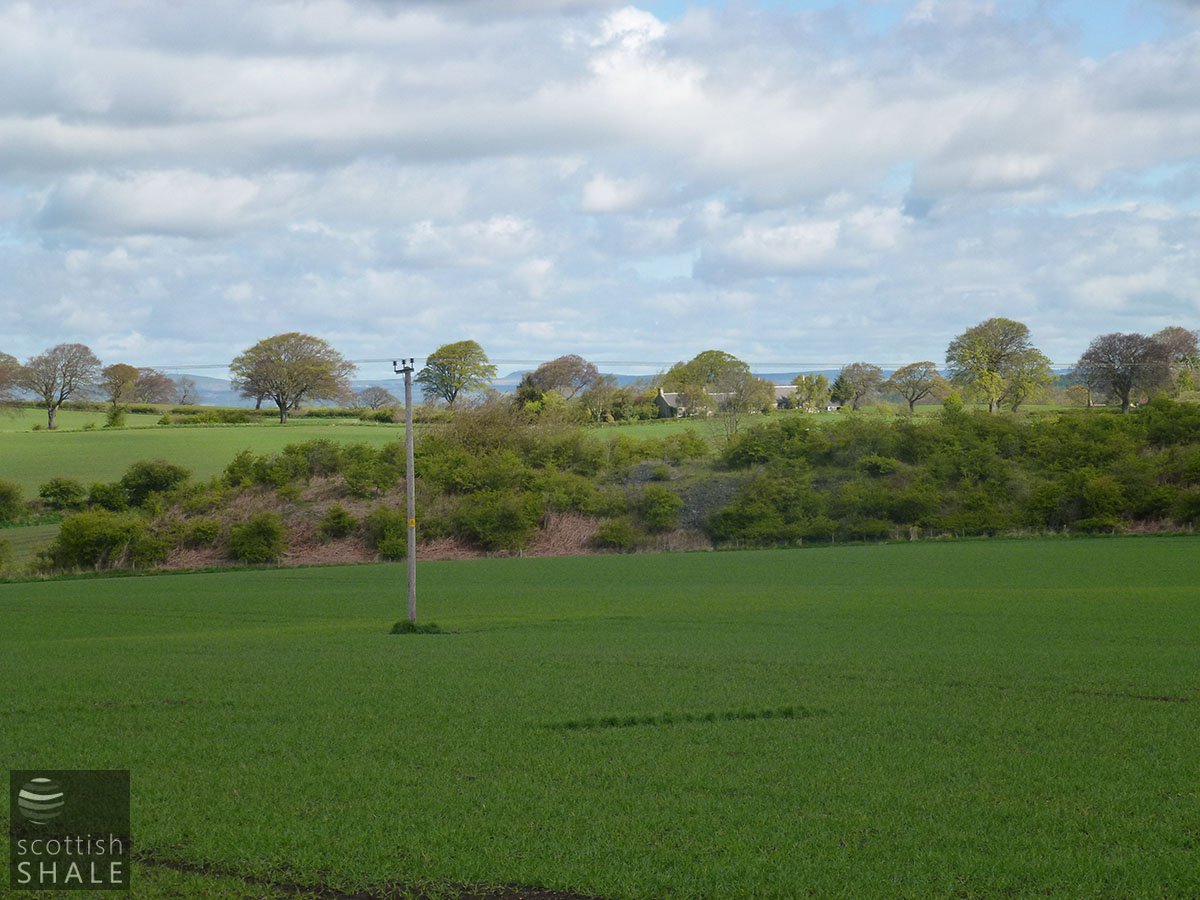
Bing of mine waste viewed from the south. Looking north. May 2012.

Mine waste spilling in to the valley viewed from the north, looking south. May 2012.
LIGHTNING STRIKES CHIMNEY STALK
During a severe thunderstorm which visited Broxburn, the chimney stalk at Hayscraigs [sic.] Mine, belonging to the Broxburn Oil Company, Ltd., was struck by lightning and completely destroyed. The stalk was 130 feet high, and was used in connection with the two steam boilers for the winding engine and other power. Apparently the current had struck the top of the stalk, demolishing about 30 feet of brickwork, and afterwards travelled downwards, causing a breach iof two feet wide in the remaining part of the stalk. Beyond the breaking of several pipes the falling debris did no damage. The lightning afterwards struck the steel winding rope, and travelled to the engine-house and down the mine. The engineman, who was in the act of winding, received a severe shock, while another man down the mine was also affected by contact with the winding rope. In consequence of the destruction of the chimney, operations at the mine will be at a standstill for some weeks, but it is probable that work will be found for the other men by @double shifting@ other mines.
Dundee Evening Telegraph, 18th January 1910
Coal Authority Mine Abandonment Catalogue No. 6934, showing workings in the Curly, Broxburn and Grey Shales from Hayscraigs Mine and Pyothall No. 5 Pit, abandoned in 1919.
Oral history transcript: Mr Archibald Fairley
- 194710 - Duplicate Minute of Agreement between the Right Honourable Ronald Douglas Stuart Mar, Earl of Buchan, Lord Cardross Baron Auchterhouse of the [...] - Duplicate Minute of Agreement between the Right Honourable Ronald Douglas Stuart Mar, Earl of Buchan, Lord Cardross Baron Auchterhouse of the First Part and The Broxburn Oil Company Limited of the Second Part, relating to the purchase of minerals of oil shale and blaes on two areas of land forming part of the Farm of Greendykes in the Parish of Uphall. Dated 8 July 1955 Includes plan of Hayscraig Quarry which highlights the areas of ground already compensated for by The Broxburn Oil Company Scale and areas of land that fall outwith the compensation boudaries. Scale of plan is 1:2500. Dated 7th February 1955.
- 195794 - Earl of Buchan, Strathbrock Minerals, Greendykes Hayscraigs Quarry. - Correspondence dated 24 November 1960 - 9 August 1962 relates to programme for starting restoration work at second opencast site at Hayscraigs Quarry. File relating to Greendykes. Loose papers (though original pinned together) now re filed together.




